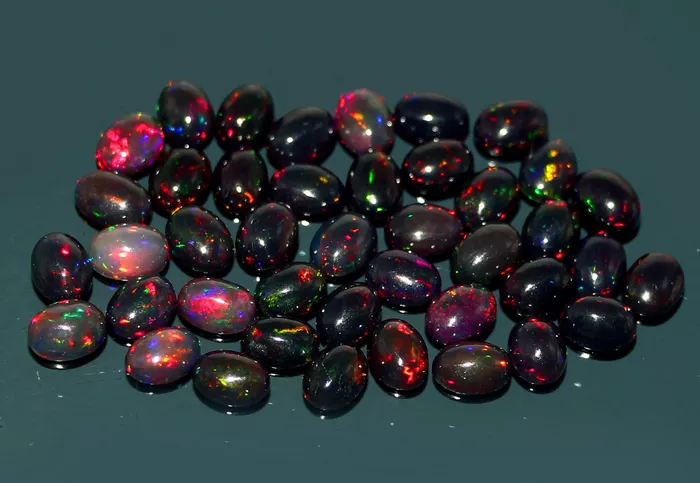Opals, revered for their stunning play of colors, are gemstones that vary widely in value depending on a multitude of factors. Understanding which opal commands the highest prices entails exploring their diverse types, distinctive characteristics, and the intricate dynamics of the gemstone market. This extensive guide aims to unravel the complexities of opal pricing, delving deep into rare varieties, factors influencing their value, and the global market trends that shape their worth.
Introduction to Opals
Opals are unique gemstones celebrated for their iridescence, known as play-of-color, which manifests as a captivating array of hues when viewed from different angles. This optical phenomenon arises from the internal structure of opals, where light diffracts through tiny silica spheres. Opals encompass various types, each distinguished by specific properties that significantly influence their rarity and market value.
Types of Opals and Their Rarity
1. Precious Opals
Boulder Opal: Found predominantly in Queensland, Australia, boulder opals are esteemed for their vibrant colors set against a natural ironstone matrix.
Black Opal: Among the rarest and most coveted, black opals exhibit a dark body tone that intensifies the brilliance of their play-of-color.
White Opal: Characterized by a light body tone, white opals display vivid colors and are more prevalent compared to their black counterparts.
2. Fire Opals
Mexican Fire Opal: Noted for its fiery orange to red hues, Mexican fire opals are prized for their transparency and vibrant coloration.
3. Common Opals
Potch Opal: Often lacking play-of-color, potch opals are opaque and commonly used in opal doublets and triplets to enhance their visual appeal.
Factors Influencing Opal Value
The valuation of opals hinges on a combination of factors that collectively determine their market worth:
Intensity of Play-of-Color: The vividness and diversity of colors visible within the opal’s play-of-color.
Pattern: Distinctive arrangements of color patches, such as harlequin, pinfire, or floral patterns, which enhance visual appeal.
Body Tone: The underlying color of the opal’s base, ranging from dark (black opal) to light (white opal), influencing the prominence of the play-of-color.
Transparency: Opals with higher transparency and depth of color are generally more valuable.
Size and Shape: Larger opals with unique shapes or formations are rarer and command higher prices.
Origin: Opals sourced from renowned regions, such as Lightning Ridge (Australia) for black opals or Querétaro (Mexico) for fire opals, often carry prestige and higher market value.
Market Trends and Pricing Dynamics
The opal market is dynamic, influenced by evolving trends in jewelry design, global demand fluctuations, and supply dynamics from key producing regions. Auctions, gem shows, and specialized dealers play pivotal roles in setting prices based on rarity, quality, and consumer preferences. Recent trends underscore a growing appreciation for ethically sourced opals with unique color patterns and larger carat weights, driving up their market value.
See Also: Precautions When Wearing Yellow Sapphire: What You Need to Know
Case Studies of Expensive Opals
The Aurora Australis: A famed black opal unearthed in Lightning Ridge, Australia, celebrated for its deep blue and green play-of-color against a dark background.
The Fire of Australia: Another notable black opal from Lightning Ridge, renowned for its vibrant red and orange hues, commanding attention for its rarity and intensity.
Mexican Fire Opal Jewelry: High-quality Mexican fire opals set in fine jewelry settings, prized for their exceptional transparency and vivid color spectrum.
Investing in Opals: Considerations and Insights
Investing in opals necessitates a nuanced understanding of market trends, gemological expertise, and meticulous authentication processes. Collectors and investors alike are drawn to opals with exceptional play-of-color, provenance documentation, and gemological certifications that attest to their quality and rarity. Strategic acquisitions focus on acquiring opals poised to appreciate in value over time, balancing aesthetic appeal with investment potential in a dynamic gemstone market.
Conclusion
Determining the most expensive opal involves evaluating a spectrum of factors encompassing type, rarity, quality, and market demand. Precious opals, such as black opals from Lightning Ridge and high-quality Mexican fire opals, frequently command top prices due to their scarcity, exceptional color play, and historical significance. Whether as an investment asset or a cherished piece of jewelry, understanding these dynamics empowers enthusiasts and investors to navigate the opal market confidently, acquiring gemstones of enduring beauty and enduring value.

